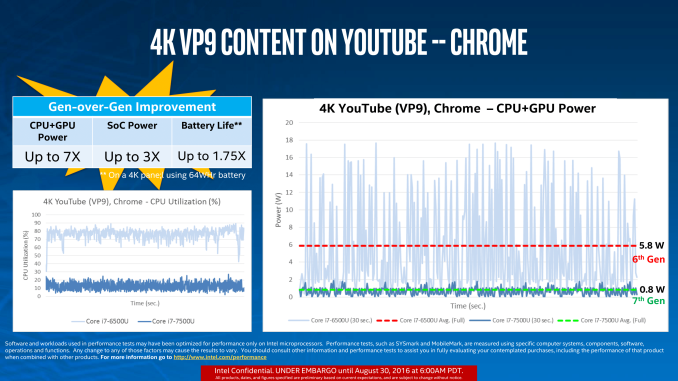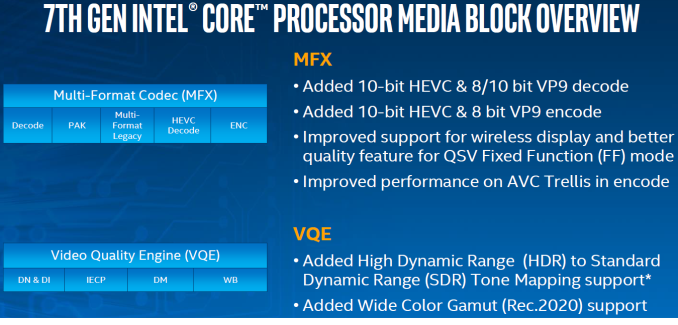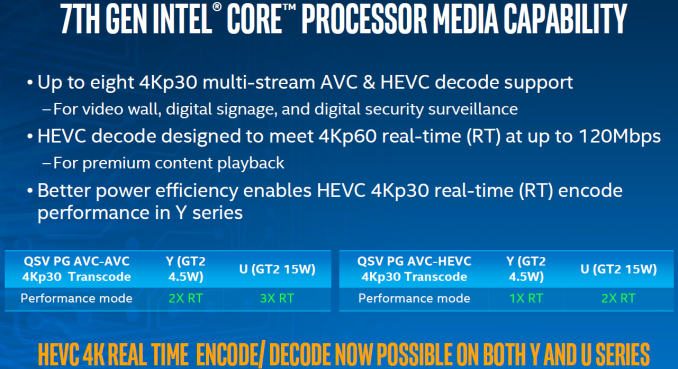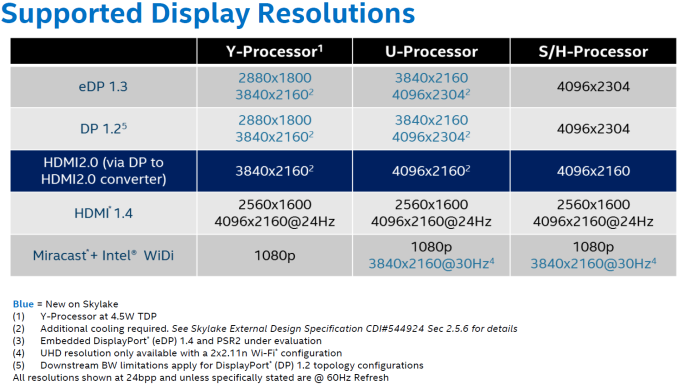Intel Launches 7th Generation Kaby Lake: 15W/28W with Iris, 35-91W Desktop and Mobile Xeon
by Ian Cutress on January 3, 2017 12:01 PM ESTThe Kaby Lake-U/Y GPU - Media Capabilities
Written by Ganesh
While from a feature standpoint Kaby Lake is not a massive shift from Skylake, when it comes to GPU matters it none the less brings across some improvements that are directly visible to the end-user. As with the CPU cores, Intel’s 14nm+ process will allow for higher GPU frequencies and overall better GPU performance, but arguably the more impressive change with Kaby Lake is the updated media capabilities. To be clear, Kaby Lake is still an Intel Gen9 GPU – the core GPU architecture has not changed – but Intel has revised the video processing blocks to add further functionality and improve their performance for Kaby Lake.
The media capabilities of the Skylake GPU were analyzed in great detail in our 2015 IDF coverage. The updates to Kaby Lake-U/Y should be analyzed while keeping those features in mind. The major feature change in the Kaby Lake-U/Y media engine is the availability of full hardware acceleration for encode and decode of 4K HEVC Main10 profile videos. This is in contrast to Skylake, which can support HEVC Main10 decode up to 4Kp30, but does so using a “hybrid” process that spreads out the workload over the CPU, the GPU’s media processors, and the GPU’s shader cores. As a result, not only can Kaby Lake process more HEVC profiles in fixed function hardware than before, but it can do so at a fraction of the power and with much better throughput.
Also along these lines, Kaby Lake has implemented full fixed function 8-bit encode and 8/10-bit decode support for Google’s VP9 codec. Skylake offered hybrid decode support for the codec, which is useful from a feature standpoint, but is a bit more problematic in real-world use since it’s not as power-efficient to use VP9 a codec implemented in fixed function hardware. Google has proven eager to serve up VP9 to its YouTube users, so they can now much more efficiently decode the codec. Meanwhile, on the encode side, brand-new to Kaby Lake is VP9 encoding support, to go with the aforementioned HEVC encode support.
An overview of the GPU engine in Kaby Lake-U/Y is presented in the slide below.
The new circuitry for hardware accelerating HEVC Main10 and VP9 are part of the MFX block. The MFX block can now handle 8b/10b HEVC and VP9 decode and 10b HEVC / 8b VP9 encode. The QuickSync block also gets a few updates to improve quality further, and AVC encode performance also receives a boost.
The Video Quality Engine also receives some tweaks for HDR and Wide Color Gamut (Rec.2020) support. Skylake's VQE brought in RAW image processing support with a 16-bit image pipeline for selected filters. While Intel has not discussed the exact updates that enable Rec.2020 support, we suspect that more components in the VQE can now handle higher bit-widths. Intel pointed out that the HDR capabilities involve usage of both the VQE and the EUs in the GPU. So, there is still scope for further hardware acceleration and lower power consumption in this particular use-case.
Intel claims that Kaby Lake-U/Y can handle up to eight 4Kp30 AVC and HEVC decodes simultaneously. HEVC decode support is rated at 4Kp60 up to 120 Mbps (especially helpful for premium content playback and Ultra HD Blu-ray). With Kaby Lake-U/Y's process improvements, even the 4.5W TDP Y-series processors can handle real-time HEVC 4Kp30 encode.
On the subject of premium content, in their presentation Intel rather explicitly mentioned that the improved decode capabilities were, in part, for “premium content playback.” When we pushed Intel a bit on the matter – and specifically on 4K Netflix support – they didn’t have much to say beyond the fact that to play 4K Netflix, you need certification. Based on what was said and what was not said (and what we know about the certification process) our educated guess is that the updates in Kaby Lake-U/Y include some new DRM requirements for 4K content, and 4K Netflix should hopefully be good to go with the new platform. However on that note, because of those DRM requirements and that this is being pitched as a new feature for Kaby Lake, we suspect that when 4K Netflix streaming does come to the PC platform, Skylake owners are going to be out of luck.
It must be kept in mind that all the encode / decode aspects discussed above are for 4:2:0 streams. This is definitely acceptable for consumer applications, as even Blu-ray video streams (that have plenty of bandwidth at their disposal) are encoded in 4:2:0. However, if Intel wants to use the new media engine in professional broadcast and datacenter applications, 4:2:2, and, to a much lesser extent, even 4:4:4 support might become necessary. For the purpose of the Kaby Lake-U/Y consumer platforms being introduced today, this is not an issue at all.
Moving on, like the GPU core itself, Kaby Lake-U/Y's display pipeline is the same as that of Skylake. This means the iGPU can support up to three simultaneous displays.
One of the disappointing aspects from Skylake that has still not been addressed in Kaby Lake-U/Y is the absence of a native HDMI 2.0 port with HDCP 2.2 support. Intel has been advocating the addition of an LSPCon (Level Shifter - Protocol Converter) in the DP 1.2 path. This approach has been used in multiple motherboards and even SFF PCs like the Intel Skull Canyon NUC (NUC6i7KYK) and the ASRock Beebox-S series. Hopefully, future iterations of Kaby Lake (such as the desktop and high-performance mobile parts coming in January) address this issue to simplify BOM cost for system vendors.
In summary, Kaby Lake-U/Y resolves one of the major complaints we had about Skylake's media engine: the absence of hardware-accelerated 4Kp60 HEVC Main10 decode. There are a few other improvements under the hood that enable a more satisfying multimedia experience for consumers. The software and content-delivery ecosystems have plenty of catching up to do when it comes to taking full advantage of Kaby Lake-U/Y's media capabilities.
















43 Comments
View All Comments
hans_ober - Tuesday, January 3, 2017 - link
i7-7820HK typo: boost frequency of 4.9GHzkenansadhu - Tuesday, January 3, 2017 - link
Oh it was a typo? I was so happy to see that. So what's the correct boost speed? I'm also curious about the price. Is it actually not more expensive than other i7 models?midspace - Tuesday, January 3, 2017 - link
should be Boost of 3.9Ghzhttp://ark.intel.com/products/97464/Intel-Core-i7-...
hansmuff - Tuesday, January 3, 2017 - link
Fist time I read about the AVX Offset feature.. pretty cool and I'm looking forward to benchmarks playing with it. I wonder what AMDs chips will do with regards to that, I can only assume they have similar thermal issues with those instruction sets.ddriver - Tuesday, January 3, 2017 - link
TICK TOCK MEHMr Perfect - Tuesday, January 3, 2017 - link
"Calculating Generational IPC Changes from Sandy Bridge to Kaby Lake"Looking forward to this one, as I've still got an i7-2600 kicking it in my machine. Maybe we can declare Sandy Bridge dead again? ;)
kmmatney - Tuesday, January 3, 2017 - link
The performance improvement from Skylake is minimal. If Skylake wasn't enough to upgrade, then Kaby lake won't be either. If you have a 2600K, especially overclocked, then you are better off buying other improvements - such as SSDs or better video cards, which you can still take along whenever you do upgrade.My personal upgrade strategy over the last 20 years was to upgrade whenever I could double my performance at the same price. I can still do this with video cards, but not with cpus.
Cellar Door - Tuesday, January 3, 2017 - link
You completely missed the sarcasm in Mr Perfect's post.And as far as upgrade strategies go, it basically always comes down to what your wallet can handle and its not black and while 2x perf. increase.
EX. new VP9 hw decode - perfect for laptops, yet nowhere near 2x perf increase in all other areas.
esterhasz - Tuesday, January 3, 2017 - link
I think that kmmatney had desktops in mind...But yeah, I'm actually pretty excited for KL in laptops. YouTube is pushing VP9 really hard and I'm curious what the Iris+ 650 will be able to do. No miracles for sure, but coming from a Haswell U-Series chip, the time's finally ripe for an upgrade.
Mr Perfect - Tuesday, January 3, 2017 - link
Yeah, that exactly what I've been doing. A 1TB 850 Evo, Windows 10 and a GTX1060 made the 2600 completely relevant again. I'm actually still feeling the limit of the GPU, volumetric lighting in Fallout 4 is too much for the 1060.